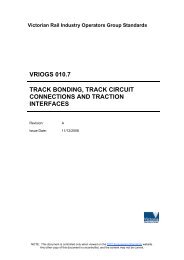St Andrews and Panton Hill: Transport Needs Assessment - Public ...
St Andrews and Panton Hill: Transport Needs Assessment - Public ...
St Andrews and Panton Hill: Transport Needs Assessment - Public ...
Create successful ePaper yourself
Turn your PDF publications into a flip-book with our unique Google optimized e-Paper software.
2.3 Social DisadvantageSocio-Economic Indexes for Areas (SEIFA) are developed as a way of gauging the social <strong>and</strong>economic wellbeing of areas (ABS, 2006). The index used below is the Index of Relative Socio-Economic Disadvantage. It considers variables such as low incomes, households without a car,low education attainment <strong>and</strong> unemployment. The rankings for the SEIFA Disadvantage DecileScale are shown below:Figure 5: SEIFA Disadvantage Scale (ABS, 2006)A map of SEIFA Disadvantage for the assessment area is shown in Figure 6. The whole of theassessment area is classified between the rankings 5 <strong>and</strong> 10, which means it is at the leastdisadvantaged end of the scale. Furthermore, Nillumbik Shire is one of the least disadvantagedlocal government areas in Victoria (ABS, 2006). Disadvantaged communities generally havelower levels of car ownership <strong>and</strong> lower income levels, <strong>and</strong> therefore have a greater need forpublic transport to access services. The low level of disadvantage for the assessment area doesnot indicate a strong need for public transport.To support these findings, the percentage of households without a car is also mapped in Figure 7.There is high car ownership levels throughout the assessment area with the entire area recordedas having 0-5% of households without a car. This is common for towns on the metropolitan fringewhere private motor vehicles are the dominant mode of transport.In 2011, 3.5% of people in the labour force in Nillumbik Shire were unemployed, compared to anunemployment rate of 5.5% for the Greater Melbourne statistical area (ABS, 2011). The Nillumbikmedian weekly family income of $2070 is much higher than the Greater Melbourne median of$1576 (ABS, 2011). These two statistics provide further evidence of the low level of disadvantagein Nillumbik Shire.Page 9
















